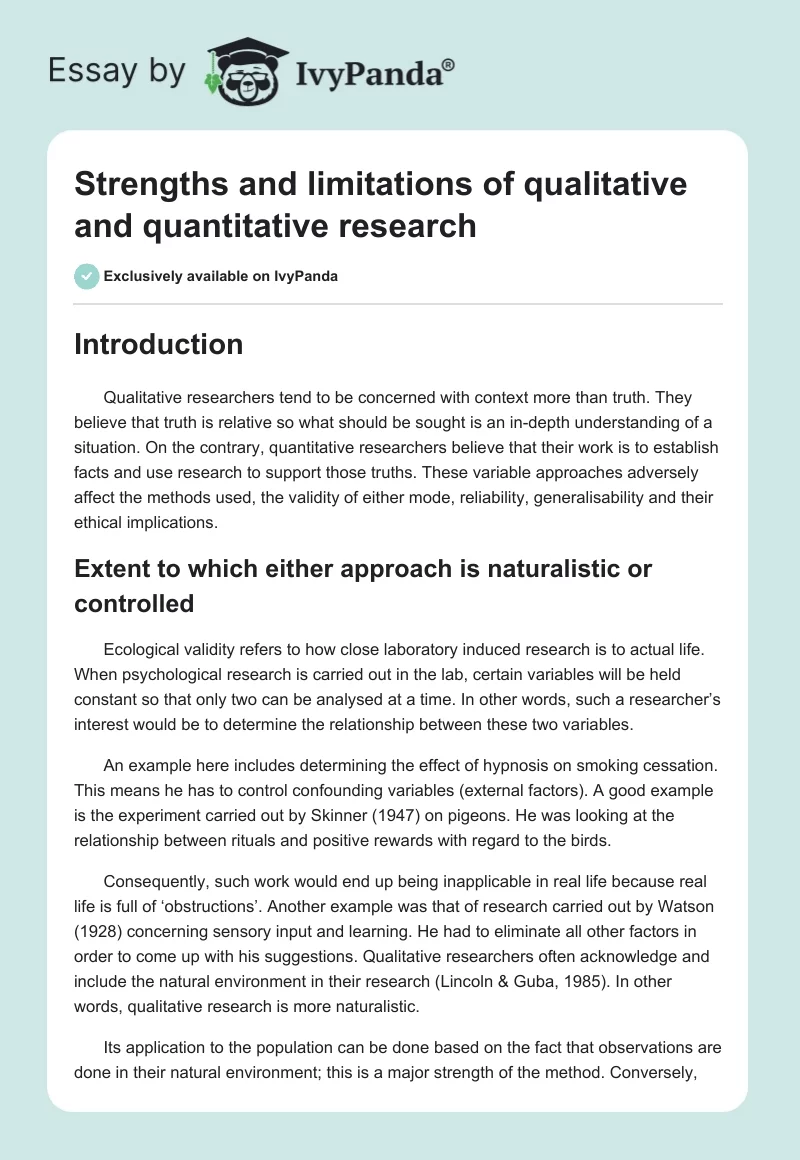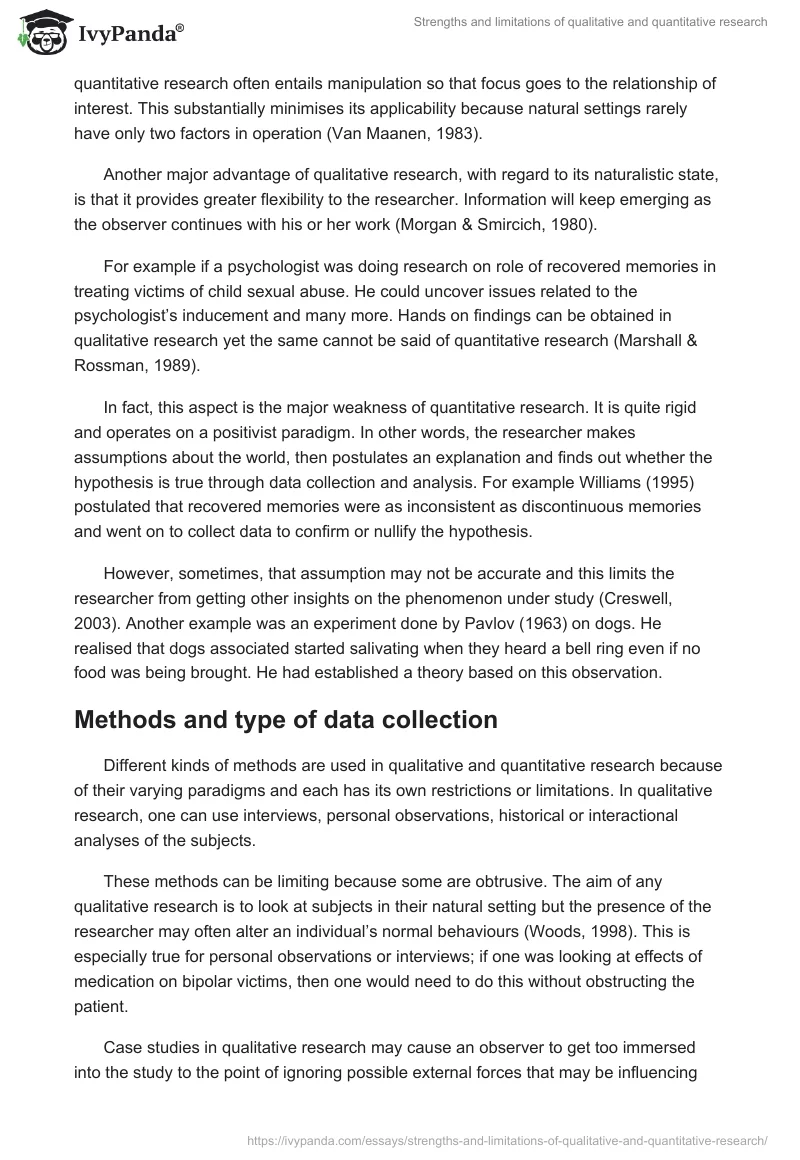Introduction
Qualitative researchers tend to be concerned with context more than truth. They believe that truth is relative so what should be sought is an in-depth understanding of a situation. On the contrary, quantitative researchers believe that their work is to establish facts and use research to support those truths. These variable approaches adversely affect the methods used, the validity of either mode, reliability, generalisability and their ethical implications.
Extent to which either approach is naturalistic or controlled
Ecological validity refers to how close laboratory induced research is to actual life. When psychological research is carried out in the lab, certain variables will be held constant so that only two can be analysed at a time. In other words, such a researcher’s interest would be to determine the relationship between these two variables.
An example here includes determining the effect of hypnosis on smoking cessation. This means he has to control confounding variables (external factors). A good example is the experiment carried out by Skinner (1947) on pigeons. He was looking at the relationship between rituals and positive rewards with regard to the birds.
Consequently, such work would end up being inapplicable in real life because real life is full of ‘obstructions’. Another example was that of research carried out by Watson (1928) concerning sensory input and learning. He had to eliminate all other factors in order to come up with his suggestions. Qualitative researchers often acknowledge and include the natural environment in their research (Lincoln & Guba, 1985). In other words, qualitative research is more naturalistic.
Its application to the population can be done based on the fact that observations are done in their natural environment; this is a major strength of the method. Conversely, quantitative research often entails manipulation so that focus goes to the relationship of interest. This substantially minimises its applicability because natural settings rarely have only two factors in operation (Van Maanen, 1983).
Another major advantage of qualitative research, with regard to its naturalistic state, is that it provides greater flexibility to the researcher. Information will keep emerging as the observer continues with his or her work (Morgan & Smircich, 1980).
For example if a psychologist was doing research on role of recovered memories in treating victims of child sexual abuse. He could uncover issues related to the psychologist’s inducement and many more. Hands on findings can be obtained in qualitative research yet the same cannot be said of quantitative research (Marshall & Rossman, 1989).
In fact, this aspect is the major weakness of quantitative research. It is quite rigid and operates on a positivist paradigm. In other words, the researcher makes assumptions about the world, then postulates an explanation and finds out whether the hypothesis is true through data collection and analysis. For example Williams (1995) postulated that recovered memories were as inconsistent as discontinuous memories and went on to collect data to confirm or nullify the hypothesis.
However, sometimes, that assumption may not be accurate and this limits the researcher from getting other insights on the phenomenon under study (Creswell, 2003). Another example was an experiment done by Pavlov (1963) on dogs. He realised that dogs associated started salivating when they heard a bell ring even if no food was being brought. He had established a theory based on this observation.
Methods and type of data collection
Different kinds of methods are used in qualitative and quantitative research because of their varying paradigms and each has its own restrictions or limitations. In qualitative research, one can use interviews, personal observations, historical or interactional analyses of the subjects.
These methods can be limiting because some are obtrusive. The aim of any qualitative research is to look at subjects in their natural setting but the presence of the researcher may often alter an individual’s normal behaviours (Woods, 1998). This is especially true for personal observations or interviews; if one was looking at effects of medication on bipolar victims, then one would need to do this without obstructing the patient.
Case studies in qualitative research may cause an observer to get too immersed into the study to the point of ignoring possible external forces that may be influencing the subjects under analysis (Hammersley and Woods, 2009). Such inclinations are known as micro blindness and will substantially undermine the credibility of the research done. This was something the psychologist Kelly (1955) discovered in his subsequent work on learning.
On the other hand, these methods of data collection may sometimes yield very minimal insights on the subject matter because of the intricacies involved. A researcher needs to create rapport with his subjects. He also needs to pick the best sample for the work. That individual should exercise utmost patience before he or she can get any tangible results from the study. In the end, some researchers may try to alter material in order for it to conform to their expectations.
Methods such as questionnaires in quantitative research are quite inflexible and often require large samples. This may prove to be expensive and quite intricate. Additionally, those methods may lead to inefficiencies in sampling and weighting and this could interfere with the accuracy of the study (Walford, 2005).
Generalisation of findings
A number of experts have often questioned the generalisability of qualitative research because more often than not, the studies maybe case studies. Researchers will focus on making observations and then generate theories to explain those findings. The major issue here is that the theory will need to be left open to interpretation.
Another researcher may have to collect a series of qualitative researches on the same subject and then draw conclusions from them. In other words, it is difficult to carry forward theories from one population to another in qualitative research (Hammersley & Atkinson, 1995).
On the flipside though, the limited nature of qualitative research in terms of generalisability allows other people in the field to work with findings and generate unexpected connections. What seems like chaos in this kind of research is actually a preface for creativity. New insights can always be found in research that lack generalisability as is the case with qualitative research. Numerical data can only provide information to a certain extent (Shumacher.& Mc Millan, 2006).
Reliability and validity
Reliability in research is defined as the extent to which the results found in that research can be consistent and reproduced utilising the same methodology (Clon, 1992). In this regard, there are three major standards that must be met in order to classify research as reliable. First, it must yield consistent results, second, it must be stable over time and third, it must yield similar results as defined by Kirk and Miller (1986).
On the other hand, Slaking (1997) simplifies this and states that a research is reliable if the methodology used can measure same behaviour again and yield the same results. Reliability is quite applicable to quantitative research because most employ measurements that are done after controlling for external factors (Balsley, 1970). This means that it is easy to verify the credibility of quantitative research using its reliability measures and this is a strong point of the research method.
For example, the studies carried out by Thorndike (1911) on connectionism established that there was a firm connection between cats’ perception of positive consequences and their actions. This psychologist has controlled for most external factors Stenbanka (2001) affirms that when a type of qualitative research can be easily tested for reliability then it is of no use in providing in depth knowledge. This is indeed a limitation in this kind of research.
Validity on the other hand, is defined as the true gauge of behaviour that the research claims to measure (Golafashani, 2003). In quantitative research paradigms, this is relatively easy to determine because there is often a construct or hypothesis that forms the basis of research and data collection.
Therefore, it is easier to determine whether the research is truthful and this is a major advantage of the quantitative paradigm. In qualitative research, a different approach to validity is necessary since issues of accuracy are always quite difficult to determine using those conventional approaches. This makes it limiting in terms of accuracy (Lacey, 2010).
Sometime mixed methods are necessary in order to mitigate the negatives of one research method by the other. For instance, in a study of women who had been victims of child sexual abuse, Williams (1991) used quantitative research by looking at criminal records of abuse to verify the subjects’ assertions. She also combined this with qualitative research in that he interviewed the women about their experiences.
Ethical implications
Qualitative research has many limitations when it comes to ethical considerations. First, a researcher must make a choice between doing overt or covert research and decide how this relates to the participants’ privacy (Strauss & Corbin, 1990). For instance, using a two way mirror to observe individuals within a certain mental institution can cause one to be treated as a spy (Harvey & Herman, 1997).
Also, some researchers may decide to obtain information from participants without really explaining to the subjects why the research is being done. In the end, this undermines the principle of informed consent (Patton, 1980). However, if those very subjects are told about the research, they may be tempted to act differently in order to impress the research. The need to keep things in their real life setting is what makes qualitative research quite tricky.
Conclusion
Quantitative research tends to be rigid and may end up providing solutions for unrealistic situations. On the flipside, this approach has high reliability and validity. Qualitative research may not be easily generalisable and it is often difficult to determine validity and reliability. Nonetheless, it places psychological phenomenon in context and allows for discovery of information as the research proceeds.
References
Skinner, B. (1947). Superstition in the pegion. Journal of experimental psychology. 38, 456
Thorndike. E. (1911). Animal intelligence. NY: Mc Millan
Pavlov, R. (1963). Psychopathy and psychiatry. Moscow: Foreign language publication
Watson, J. B. (1928). Psychological Care of Infant and Child. New York: Norton Company
Kely, G. (1955). The psychology of personal constructs. NY: Norton
Williams, L. (1995). Recovered memories in women with child sexual victimization histories. Traumatic stress Journal, 8(4), 649-673
Harvey, M. & Herman. J. (1997). A naturalistic study – adulthood memories of child trauma. Traumatic stress journal, 10(3), 557-571
Strauss, A. & Corbin, J. (1990). Basics of qualitative research. CA: Sage
Clon, J. (1992). Concept of reliability as it pertains to data from qualitative studies. South west educational research association, Houston
Golafashani, N. (2003). Understanding reliability and validity in qualitative research. Qualitative report, 8(4), 597-607
Lincoln, Y. & Guba, E. (1985). Naturalistic inquiry. CA: Sage
Johnson, B. (1997). Examining the validity structure of qualitative research. Education journal, 118(3), 282
Kirk, J. & Miller, M. (1986). Reliability and validity in qualitative research. CA: Sage
Shumacher, S.& Mc Millan, J. (2006). Evidence based inquiry for research in education. NY: Pearson education
Stenbacka, CC. (2001). Qualitative research requires quality concepts of its own. Management decision, 39(7), 551-555
Creswell, J. (2003). Research design: qualitative, quantitative and mixed methods approaches. London: Sage
Woods, P. (1998). Critical moments in the “Creative Teaching” research’. London, Routledge,
Lacey, M. (2010). Problems of sociological fieldwork: a review of the methodology of Hightown Gramar. London: Routledge
Hammersley, M. and Woods, P. (2009). The Process of schooling. London, Routledge
Walford, G. (2005). Doing Educational Research. London, Routledge.
Hammersley, M. & Atkinson, P. (1995). Ethnography: Principles in Practice. London, Routledge
Van Maanen, J. (1983). Qualitative methodology. CA: Sage Publications.
Patton, M. (1980). Qualitative evaluation methods. CA: Sage.
Morgan, G., & Smircich, L. (1980). The case for qualitative research. Academy of Management Review, 5, 491-500.
Lincoln, Y., & Guba, E. (1985). Naturalistic inquiry. CA: Sage Publications.
Marshall, C. & Rossman, G. (1989). Designing qualitative research. CA: Sage Publications.
Balsley, H. (1970). Quantitative research methods for business and economics. New York: Random House.


